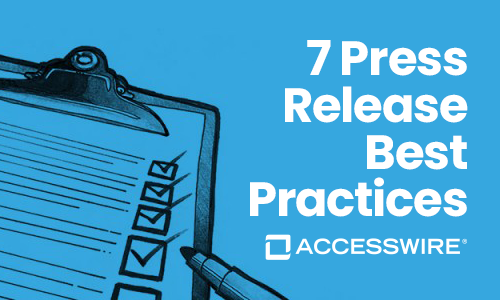How to Get Press Coverage for Your Business: A Guide
As a business owner in the United States, you know your business news is important. But when it comes to informing audiences about new products and promotions, you don’t know how to reach the widest possible audience.
After all, if audiences don’t know about your important news, your brand stands little chance of growing into all that it could be.
Fortunately, you don’t have to wallow in the desert of obscurity. That’s because there are ways to get the media coverage you deserve. In this guide, we’ll discuss how to get media coverage for your large or small business by focusing on a few strategies to turn journalists’ heads each time you make a company press release.
The Benefits of Press Coverage
Before we dive into how to get press coverage, let’s explore its benefits.
Press coverage is beneficial for several reasons. These reasons include:
- Brand visibility – Although some businesses do still grow primarily by word-of-mouth and local marketing, most businesses rely on press coverage to create brand awareness. This is because press coverage allows your brand to reach audiences miles (even continents) away from your business. Press coverage harnesses the power of the Internet and other forms of global and local media to reach the largest possible audience.
- Builds relationships – Effective press coverage mostly involves building solid relationships with journalists, bloggers, and other media members. Yet these relationships aren’t important only at the time of the company press release. Strong relationships with media outlet members can help your brand grow over time.
In short, the adage “no news is good news” applies in some situations. However, “positive news is always good news” applies in all situations involving press coverage.
How To Get Press: Tips
Although getting press coverage may seem like a daunting task, it doesn’t have to be. That’s because a little research and determination go a long way.
Here are a few tips to ensure your business receives good coverage.
1. Do Your Research to Become an Industry Insider
The old phrase “it takes one to know one” is incredibly true in the world of PR. To receive the best press coverage, it’s beneficial to know the ins and outs of your industry.
That’s where research comes in. Research every aspect of your industry—from the best journalists and bloggers to the best publications.
Even better: place yourself in the industry journalists’ shoes. If you were covering your business, what would excite or inspire you? What’s a story you’d like to write, an angle you’d like to focus on?
Knowing your industry like the back of your hand will help you direct your attention where it needs to go. You’ll know exactly where to pitch your news so that you don’t waste time pitching to sources that aren’t in your industry.
2. Pitch Like A Pro
Nope, we don’t mean pitching like a relief pitcher in the bottom of the ninth with two outs.
We mean pitching your news in the most engaging, relevant manner possible. Without a hard-hitting pitch, media outlets might not find your news not worth their time. When it comes to PR for a small business, it’s ultimately up to you to make them care.
To pitch like a pro, first think about the type of news you’re pitching. Here are a few types of press releases:
- Event releases
- New product releases
- New partnership releases
- New hire releases
- Award releases
Once you know the type of news you want to share, it’s time to think about the specific pitch.
While pitches do somewhat vary based on the news type, most (if not all) great pitches have the following characteristics:
- Engaging subject line
- Personalized and specific message
Including these characteristics in your pitch email will help ensure your pitch gets read. Mastering PR for startups and all other business models can define their success, so let’s break down these important characteristics.
Engaging Subject Line
Writing a boring subject line is one of the easiest ways to get your pitch sent to the trash folder before it even gets opened.
Instead, your subject line should be written with engagement (and panache) in mind. In other words, aim to make your subject line stand out so that journalists have to open your email (if only to satisfy their own curiosity).
Here are a few ways to make your subject line shine:
- Write with concision, write with power – Email subject lines should be short—no more than 8 words. That said, make your subject line powerful by including active verbs that entice readers to open the email. It may also be helpful to include the word “pitch” at the beginning of your subject line.
- Don’t be overly witty – We know we said that your subject lines should be engaging. However, this doesn’t mean your subject lines should “try too hard.” Subject lines that are overly witty or confusing run the risk of annoying your readers. It’s possible to be both straightforward and engaging.
- Include compelling data when possible – Few things command attention better than hard facts and statistics. Help your readers understand why your pitch is worth considering by including statistics in your subject line. For example, if you’re pitching a product and have done research on consumer demand, mention this data in your subject line.
Personalized and Specific Message
Now that you’ve written your subject line, it’s time to write the body of the email.
Emails should pitch the gist of your news in a manner similar to your subject line: with power and concision.
What’s more, emails should be personalized to fit the needs and vibes of the specific publication.
For example, if an editor requests pitches of no more than a paragraph, don’t include a four-paragraph precis complete with a thesis statement.
In addition, do the following:
- Personalize your email by addressing the receiver by name.
- Write concisely, including the who, what, where, when, why of your news.
- Convey “newsworthiness” by mentioning your news's timeliness, human interest, and/or immediate impact.
Finally, make sure you proofread your email. The last thing you want is a misplaced comma or misspelled word distracting your reader.
3. Be Proactive
Even before you pitch to an editor, there are things you can do to be on the industry’s radar. While some of these activities revolve around business, others involve helping out in the community.
Let’s take a look at a few proactive measures you can take before editors even open your first pitch.
Blog
Just because a third party hasn’t yet written about the amazing things your business is doing doesn’t mean you can’t get your name out there.
Instead of simply waiting for a publication to pick up your story, take charge by blogging.
Maintaining a blog on your website is a smart way to let the industry know you’re making waves in your field. What’s more, blogging lets audiences know who you are and what your company’s about.
Some companies and publications even allow guest blogging. If a publication initially rejects your pitch, they may allow you to author a guest blog post. This guest post may, in turn, lead to press coverage later on.
Finally, consider syncing your news to an online newsroom like ACCESSWIRE. A standout in the news distribution industry, ACCESSWIRE uploads your press releases to their online newsroom, making your news always visible to the audiences who matter most.
Host Community Events
Many journalists and publications are looking for companies with more than just great business concepts. They’re also looking for companies making positive impacts in their communities—especially in terms of diversity initiatives and philanthropy.
In short, publications may be more inclined to cover your company if there’s a “feel-good story” attached.
That said, this doesn’t mean that you should engage in community service simply to get press coverage. Instead, treat press coverage as a secondary benefit to your charitable service.
To give back to your community (and potentially receive great coverage), consider sponsoring the following:
- Coat drives/back-to-school events
- Charity 5Ks
- Community softball games
- Business "open-houses"
Any activity designed to build community helps get your name out there while helping a good cause.
Stay Active on Social Media
Whether we like it or not, social media has a huge influence on press coverage. If your company has a large social media following, publications may be more inclined to pick up your news as this can translate into more followers for them.
Staying active on a social media platform doesn’t necessarily mean becoming an “influencer” (although this certainly couldn’t hurt). But it does mean continually generating relevant and exciting content on your social media platform.
In terms of press coverage, Twitter is especially important. Many journalists and industry insiders use Twitter to find the latest scoop.
Use Twitter to connect with these sources, build relationships, and spread company news as soon as it arises.
Make Headlines With ACCESSWIRE
For new businesses, exposure is everything. What good’s developing new products and services if nobody knows about them?
That said, getting media attention can be difficult—especially if your business has yet to build a reputation in the industry. From forming relationships to perfecting your pitch, the list of things to do to get covered can seem endless.
If only there were a way to connect your news with the widest possible audience . . .
Fortunately, there is! With ACCESSWIRE, you can reach the audiences who matter. Through wide distribution and flat-fee pricing, we make it easy to share your news with the world.
Join ACCESSWIRE’s press release service today and start getting the media attention and coverage you deserve.
Sources:
Linchpinseo. How To Get Press And Media Coverage For Your Small Business.
Prowly. Media Pitch Subject Lines – Best Practices & Examples.
Similar Blog Posts
PRODUCTS
ACCESSWIRE | All Rights Reserved




